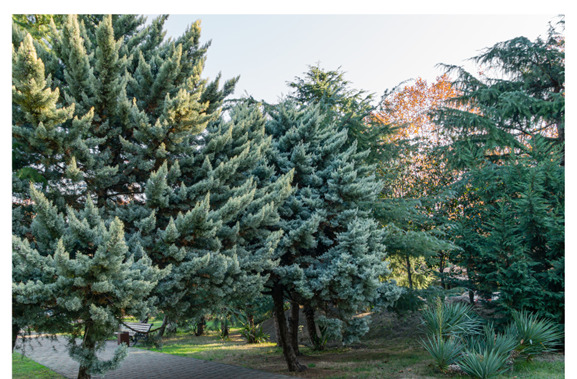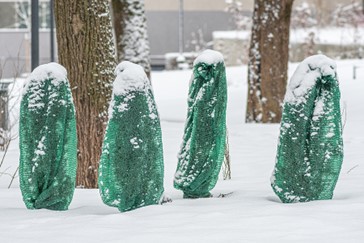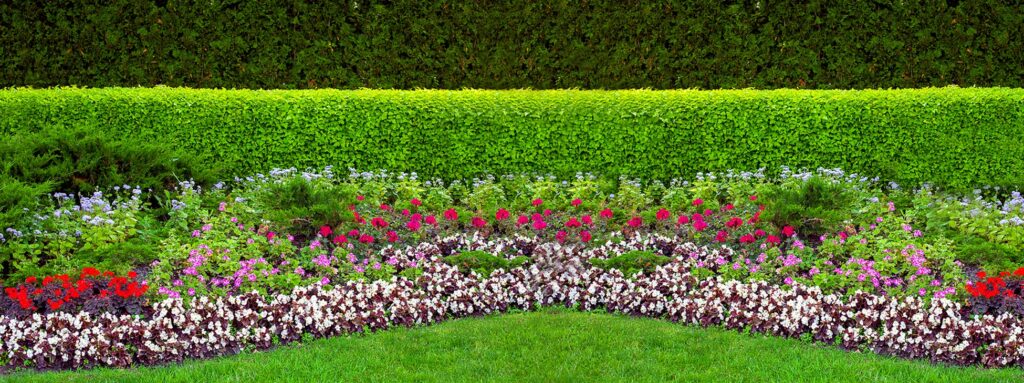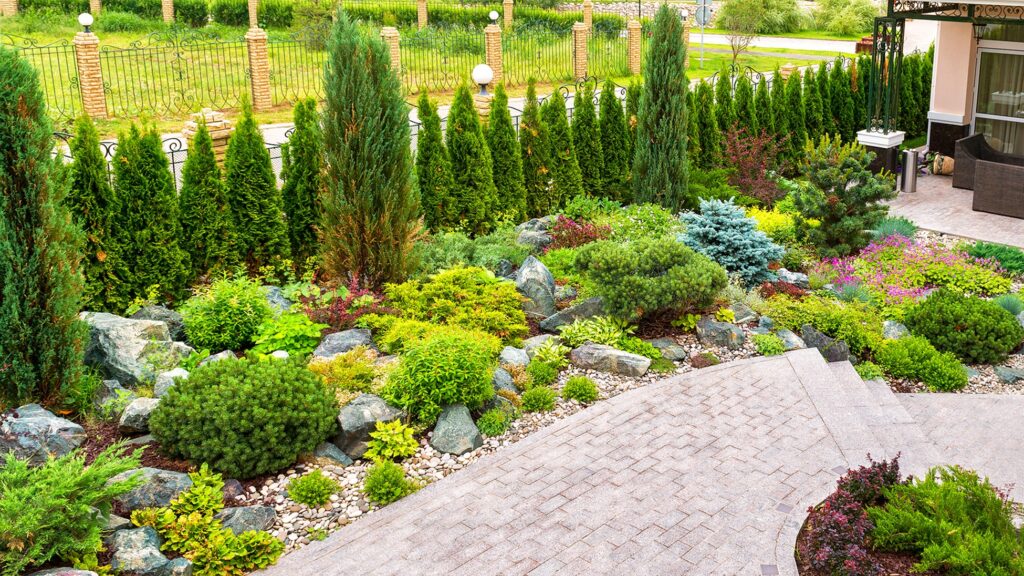
Pruning is an essential part of tree care, and when done correctly, it can promote healthy growth, improve aesthetics, and ensure safety. However, not all trees should be pruned at the same time.
Timing is Key
Tree pruning is a vital aspect of tree care that should be timed carefully to ensure the best results. Each type of tree has its own pruning schedule, with considerations for disease prevention and aesthetic appeal. The majority of trees are pruned from November to March. Whether you’re maintaining deciduous, fruit, flowering, evergreen, or oak trees, following the appropriate pruning timeline is crucial for their well-being.
Late Winter to Spring Pruning: Deciduous Trees
Early spring, just before new growth begins, is an ideal time to prune deciduous trees such as maples, oaks, and birches. Pruning during this period allows you to shape the tree before it becomes too dense, promoting proper branching and structure. Removing dead or damaged branches at this time also helps prevent the spread of diseases as the tree enters its active growing season.
Maples should usually be pruned in the late spring and summer after it has fully leafed. Earlier pruning can cause sap to weep, which could weaken younger trees. Japanese Maples can be structurally pruned in Winter but can be fine pruned in late spring.
Late Winter to Early Spring: Fruit Trees
Fruit trees, like apple and pear trees, benefit from pruning during late winter to early spring, ideally before bud break. This timing encourages healthy fruit production by allowing sunlight to penetrate the canopy, improving air circulation and reducing the risk of diseases like fire blight.

Late Winter to Early Spring: Flowering Trees
Flowering trees, such as cherry and dogwood, should also be pruned during late winter to very early spring. This timing ensures you won’t accidentally remove flower buds, preserving the tree’s beautiful blossoms for the coming season. You can trim away dead or diseased branches to enhance the tree’s overall appearance.
Late Winter to Early Spring: Evergreen Trees
Evergreen trees should usually be pruned in late winter to early spring while dormant. Be cautious not to cut too much, as evergreens may struggle to recover from heavy pruning. Exceptions to this timing might be arborvitae that can handle heavier pruning in spring and early summer. Junipers can also be pruned in later spring if needed.
Late Fall to Early Winter: Oak Trees
Oak trees, in particular, should be pruned during late fall to early winter to minimize the risk of oak wilt disease transmission by sap-feeding beetles. Pruning oak trees during their dormant period helps maintain their health and vitality.
Tree Pruning Times to Avoid
Pruning in the fall is generally not recommended for most tree species because it can harm their health. Fall is when trees prepare for winter dormancy, and pruning during this season can potentially stress the tree and make it more susceptible to diseases and cold damage. However, there are some exceptions and specific situations where fall pruning may be appropriate:
Dead or Hazardous Branches
If you notice dead, damaged, or hazardous branches that pose an immediate danger to people or property, it’s essential to address them promptly, regardless of the season. Safety should always be a top priority.
Remember that proper pruning techniques are equally important as timing. You also want to avoid improper pruning techniques that could harm your trees. For significant pruning or if you’re unsure about the best approach, it’s wise to consult with a professional tree service like Frontier Tree Service.

The Pacific Northwest is known for its wet winters and dry summers, making it hard to find trees that are good in drought. But there are plenty of drought-tolerant trees that are native to the region, as well as some non-native varieties that can thrive in our climate.
Unfortunately, the prolonged drought we are beginning to experience could have long-term and potentially devastating effects on our forests. A single season of drought-induced stress may not be enough to kill a tree, but repeated exposures can be fatal. Newly planted trees are particularly vulnerable to these conditions, and weakened trees are more likely to succumb to disease or insect infestations.
According to some climate projections, annual average global temperatures could rise between 1.5 and 7 degrees Celsius (2.7 to 12.6 degrees Fahrenheit). The winters are expected to be wetter and summers to be dryer.
The Pacific Northwest is home to some of the most diverse coniferous trees in the world. Their deep root systems are better able to reach moisture in the ground, making them more resistant to drought conditions. Their ability to withstand cold temperatures and high winds makes them ideal for the region’s climate.
Here are just a few of the drought-tolerant trees that do well in the Pacific Northwest Landscape:
- Maidenhair Tree (Ginkgo biloba) – The Ginkgo tree has beautiful fan-shaped green to yellow leaves. It is a popular fall specimen tree and grows 25-50 ft. tall and 25-35 ft. wide.
- Golden Rain Tree (Koelreuteria paniculata) – This is a small deciduous tree with a rounded canopy and bright yellow flowers in summer. It can grow 30 to 40 feet tall high and equally as wide.
- Dwarf Strawberry Tree (Arbutus unedo ‘Compacta’) – This popular tree has reddish peeling bark and pinkish-red fruits similar to strawberries. This tree is a slower grower, about 8-10’ tall and wide at maturity.
- Western Redbud (Cercis occidentalis) – his native plant has bright pink flowers in spring and green, heart-shaped leaves. It grows to about 10-18’ tall and wide.
- Incense Cedar (Calocedrus decurrens) – This popular evergreen is a dense conifer that grows 70-90’ tall and 50’ wide.
- Bur Oak (Quercus macrocarpa) – This hardy oak can grow to a height of 70–80′ and a spread of around 80′ at maturity. It has textured bark and large acorns for wildlife.
- Eastern Red Cedar (Juniperus virginiana) – This heat-tolerant evergreen can grow to a height of 40–50′ and a spread of 8–20′ at maturity.
- White Fir (Abies concolor) – This fairly slow-growing fir tree can grow to a height of 30–50′ and a spread of about 20′ at maturity. It is also not bothered by pests.
- Japanese Zelkova (Zelkova serrata) – This medium to large deciduous tree typically grows to 50-80′ tall and is often used as a street tree or shade tree.
You can plant drought-tolerant trees with other drought-tolerant plants in the garden. Drought-tolerant trees still need nurturing for the first three years. They’ll be less stressed if planted in late winter or early spring. Don’t forget to water your trees while they’re getting established. Continue to water them even after established.
If you need help with tree planting or other tree care services, call us at 360-574-4125.

Winter is a season of extremes in the Pacific Northwest, and on occasion, wreaks havoc on the trees that call the area home. However, there are many things one can do to protect trees in winter.
The main concerns winter brings for trees are uninvited, gnawing pests, dry, non-insulated soils, and damage from snow and high/dry winds.
Young and newly planted trees are the most susceptible to winter damage and need the most help though mature trees can and do fall prey as well. Avoid these problems by pruning, mulching, and guarding.
Prune in Winter
A reason for pruning in the winter is due to prevent snow/wind damage. Though the scene of snow resting atop tree branches is beautiful, it poses real-life risks. The weight of snow can be heavy on branches and poses the risk of falling limbs or uprooting entire trees, causing harm to the tree and possible structural damage to buildings or physical harm to passersby.
The trees most susceptible to snow damage are those with multiple leaders (more than one lead trunk), clump-forming trees, and upright evergreens. Heavy, dry winds pose a similar threat of falling branches, so removing risky branches sooner can avoid issues later if high winds are in the forecast.

An important part of tree protection in winter is pruning. Pruning is strongly dependent on the type(s) of trees (deciduous, evergreen, fruiting, ornamental) and the purpose of the pruning. Remember that pruning in the winter will encourage vigorous new growth in the spring, so plan accordingly.
Structural pruning can help shape the tree by selecting a central leader and removing dead, damaged, and dangerous (risky, susceptible to falling or “failure”) branches. It can be done on mature trees to limit falling branches, and strongly recommended for young trees to encourage stronger branching and reduce the need for heavy pruning in the future.
Winter Watering
The same snow that is bad for the branches above is much needed for the soil below to help keep the soil moist and protected from drying winds. Do one’s part by keeping soil well watered throughout the season, as moist soil helps to insulate roots better and receive more water than dry soil, which makes water penetration difficult if frozen. Be sure watering is thorough and deep enough to penetrate the root zone, ranging from 12”-18”.
Mulching Matters
Mulching is another way to help the soil around your trees. Mulching is an important tool to help insulate the roots and helps prevent the soil from drying or freezing completely, which can damage the tree through uprooting from alternating freeze/thaw cycles through the season.
Uprooting poses the risk of exposing tender roots to harsh winter sun and drying winds, while frozen soil prevents trees from replacing water after moisture loss from evaporation and transpiration. The temperature of the soil is higher than that of the temperature of the surrounding air.
Provide a protective barrier from the wind with 4”-6” of bark mulch, straw, or better yet, the leaves of the trees to act as mulch. Be sure the mulch is at least 6” away from the base of the tree, no mulch volcanoes! It can lead to rot if left to soak and discourages rodents from nesting by or eating the trunk.
Apply Tree Guards
As for guarding trees, winter is when food is scarce for wildlife, and young tender trees and the bark of mature ones are excellent sources of food. Though to the dismay of the gardener who admires said tree. Apply tree guards of plastic or wire around the tree at least 8” away from the tree to deter deer as best as one can.

Applying burlap or ¼” hardware cloth (not plastic) around the tree to at least 18” above the anticipated snow line can protect the tree from direct contact with snow, soaking the bark and creating fractures.
Wrapping trees with burlap can help prevent sunscald or frost cracks. Sunscald is when on warmer winter days, one side of the tree, typically the Southwest side, receives unusually warmer temperatures than the rest of the tree. When temperatures drop back to freezing at night, it can cause the tree’s cells to erupt. Frost cracks similarly occur on trees with darker-colored bark. When they receive bright winter sun exposure, which warms them up, they cool quickly at night, causing cracks from frozen water inside the cells.
We love to care for your trees and give you tips for protecting trees in winter. Give us a call at 360-574-4125.

The Pacific Northwest wouldn’t be what it is without the majestic conifers that drape our mountainsides, adorn our homes during the holidays, and give year-round structure within our gardens.
Conifers are the “bones” of the landscape, offering a variety of colors, shapes, and sizes. Need a screen or hedge to hide nuisances? Arborvitae. Want to add a waist-high shrub for the entrance to your walkway? Japanese Yew What city center is complete without a Blue Spruce?
Conifers, or trees and shrubs that bear cones, feature needle-like or scale-like leaves compared to their broadleaf counterparts (think maple leaf). Given the amount of rain the Pacific Northwest receives, conifers are very much at home and can grow much larger than elsewhere with less annual rainfall. (An important thing to consider when planting and designing with these plants).
There lies a misconception that conifers are all green. While they do offer the swath of greens, wide varieties express the total capacity of the rainbow from yellows (pines), blues (spruce), reds (sequoia), oranges (larch), and purples exist and are pretty popular.
Although most conifers are typically evergreen, a few deciduous plants exist among the ranks (Ex. larch, sequoia, and Bald Cypress).
The only limit to a design with conifers is one’s imagination. An entire landscape could be made using only coniferous trees and shrubs, and it could still rival a spring/summer annual and perennial bed with color and texture.
When designing conifers, the shape of the tree or shrub is something to consider. When thinking of an evergreen, the image of a pyramidal Christmas tree comes to mind. Conifers come in an array of shapes, ranging from a thin columnar form to a creeping form, hugging the ground or cascading off a wall. If space allows, consider a pyramidal specimen to draw attention at the center of a yard.
For the ambitious and for those who are comfortable with constant pruning to maintain the desired form, topiary is also an attractive option. Otherwise, conifers offer a low-maintenance, colorful, versatile, and dependable plant palette for design.
The size of your yard should be considered when selecting conifers. These plants can grow from 1 inch to more than a foot per year. The American Conifer Society has created a system to categorize the sizes of available conifers.
Evergreen conifers to consider for your garden include:
- Incense Cedar
- Alaskan Cedar
- Japanese umbrella Pine
- ‘Chief Joseph’ Lodgepole Pine
- Japanese Yew
- Sitka Spruce
Deciduous conifers to consider for your garden include:
- Western Larch
- Dawn Redwood
- Bald Cypress

Hedges are an easy, inexpensive, and low-maintenance way to add beauty and privacy to your garden or property. Whether you’re looking to plant a hedge that provides a lush green frame around your house or one that creates dense screening between you and your neighbors, there are tons of options available on the market and at local nurseries and garden centers.
To help you narrow down your choices, here are some plants that do well as hedges, along with information about their size, color, shape, and other qualities to help you find the best fit for your space.
Picking the Right Shrub
Shrubs are an important element of the garden and can provide a range of benefits. When it comes to hedges, there are a number of plants that work well depending on your location and needs. Generally, shrubs should be at least two feet tall, but they’ll grow taller over time. Here are some varieties to consider for your garden hedges.
Privet (Ligustrum vulgare) is excellent for privacy since it grows as high as 20ft in height. Privet will grow in any type of soil, even sandy soil with few nutrients. Privet may have to be trimmed more often than other shrubs if you don’t want its invasive roots pushing up into the ground and causing cracks or damaging nearby plantings.
Azalea (Rhododendron simsii), which will reach heights up to 15 ft or so with arching branches, making them excellent screens. Azalea flowers can be white, pink, red, or purple. Azaleas will grow well in partial sun as long as they get plenty of water during the summer. Azaleas make great additions to any garden as they provide an excellent focal point and give a natural feel to the property.
Yew (Taxus baccata) is commonly used because it is evergreen so it doesn’t need trimming or shaping like other hedging plants. Yew can grow up to 20 feet tall and live more than 100 years. Yew hedges can also provide lots of shade.
Arborvitae (Thuja occidentalis) is a tall, evergreen tree. It grows best in well-drained soil, so if you’re trying to use this plant as a hedge along the border of your property, be sure that you have plenty of space and place it where there are no puddles or dips. The average height of arborvitae is about 25 feet high and 15 feet wide.
Boxwood (Buxus sempervirens) is a shorter hedge option. Boxwood can grow up to 8 ft tall and is great as a small hedge or foundation plant. It requires little maintenance beyond occasional trimming and can be planted in the sun or shade.
Leyland Cypress (Cuprocyparis leylandii) is a fast-growing evergreen conifer (24 to 48 inches per year) so is often used as a hedge tree. It has a columnar to narrow-pyramidal growth habit.

Hedge Maintenance
Hedges are ideal plants for the garden because they can provide privacy and protection while being aesthetically pleasing.
The easiest way to maintain your hedge is to plant it in an area where it receives ample sunlight and keep weeds at bay by periodically weeding the hedge.
You may also want to trim your shrubs regularly with shears or pruning shears so that it does not grow out of control or have spindly branches poking into windows or other places you would like to be private. Pruning a few times per year will help make sure that your hedges stay neat without taking up too much of your time.
Regular hedge pruning prevents dead or dying branches, allowing the plant to flower or thrive in general. Pruning isn’t done to slow growth but to stimulate it. If there are bare spots, proper pruning can help fill in spaces. Excessive overgrowth can also be harmful to your hedge as it can reduce the amount of light and moisture it receives, slowing its growth.
Call us for hedge pruning for your landscape at (360) 574-4125.











